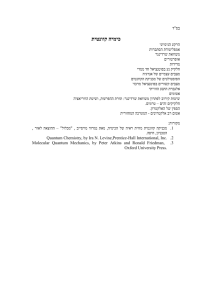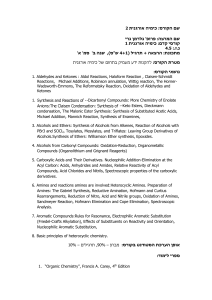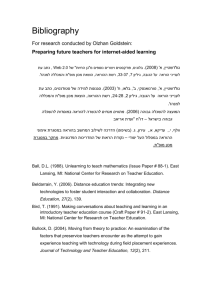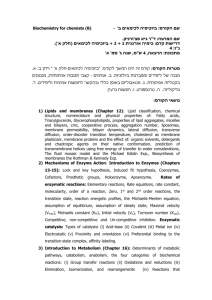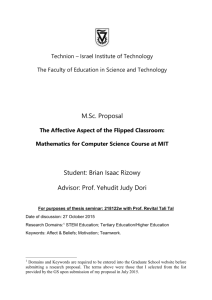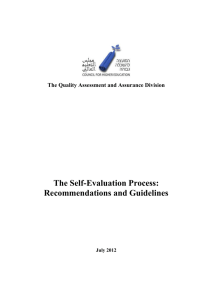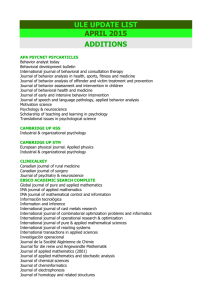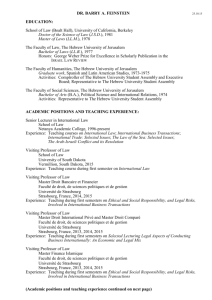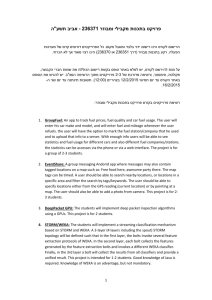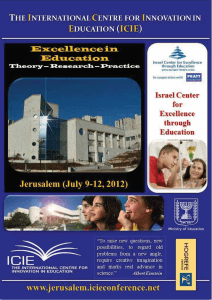רשימת מקורות - Department of Science Teaching
advertisement
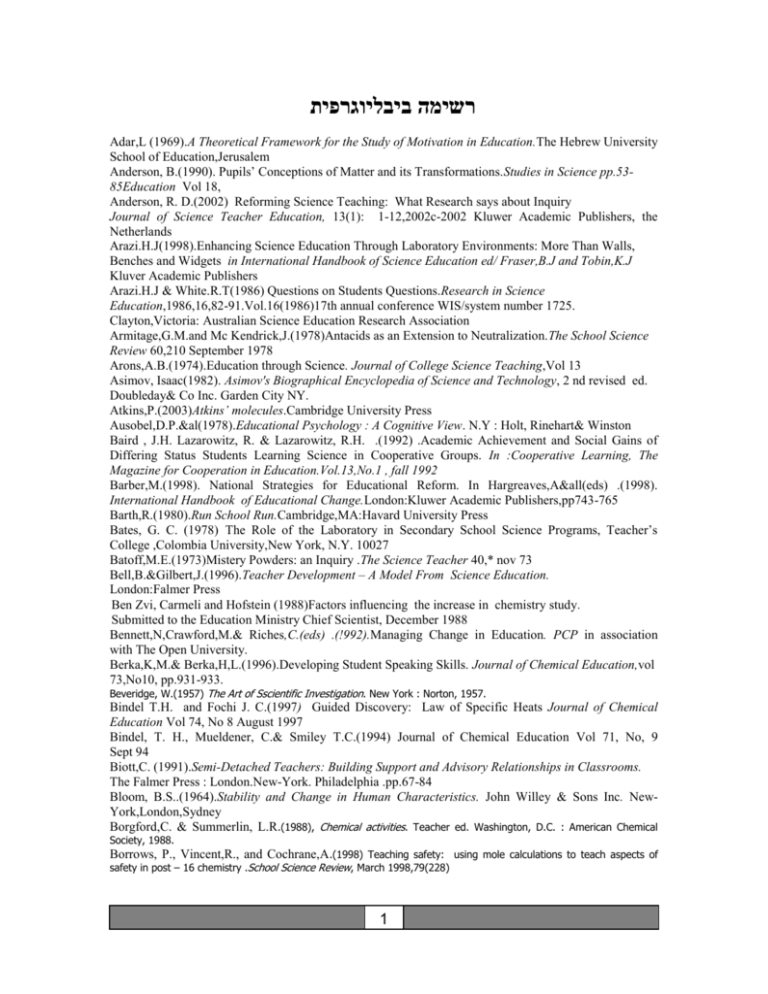
רשימה ביבליוגרפית Adar,L (1969).A Theoretical Framework for the Study of Motivation in Education.The Hebrew University School of Education,Jerusalem Anderson, B.(1990). Pupils’ Conceptions of Matter and its Transformations.Studies in Science pp.5385Education Vol 18, Anderson, R. D.(2002) Reforming Science Teaching: What Research says about Inquiry Journal of Science Teacher Education, 13(1): 1-12,2002c-2002 Kluwer Academic Publishers, the Netherlands Arazi.H.J(1998).Enhancing Science Education Through Laboratory Environments: More Than Walls, Benches and Widgets in International Handbook of Science Education ed/ Fraser,B.J and Tobin,K.J Kluver Academic Publishers Arazi.H.J & White.R.T(1986) Questions on Students Questions.Research in Science Education,1986,16,82-91.Vol.16(1986)17th annual conference WIS/system number 1725. Clayton,Victoria: Australian Science Education Research Association Armitage,G.M.and Mc Kendrick,J.(1978)Antacids as an Extension to Neutralization.The School Science Review 60,210 September 1978 Arons,A.B.(1974).Education through Science. Journal of College Science Teaching,Vol 13 Asimov, Isaac(1982). Asimov's Biographical Encyclopedia of Science and Technology, 2 nd revised ed. Doubleday& Co Inc. Garden City NY. Atkins,P.(2003)Atkins’ molecules.Cambridge University Press Ausobel,D.P.&al(1978).Educational Psychology : A Cognitive View. N.Y : Holt, Rinehart& Winston Baird , J.H. Lazarowitz, R. & Lazarowitz, R.H. .(1992) .Academic Achievement and Social Gains of Differing Status Students Learning Science in Cooperative Groups. In :Cooperative Learning, The Magazine for Cooperation in Education.Vol.13,No.1 , fall 1992 Barber,M.(1998). National Strategies for Educational Reform. In Hargreaves,A&all(eds) .(1998). International Handbook of Educational Change.London:Kluwer Academic Publishers,pp743-765 Barth,R.(1980).Run School Run.Cambridge,MA:Havard University Press Bates, G. C. (1978) The Role of the Laboratory in Secondary School Science Programs, Teacher’s College ,Colombia University,New York, N.Y. 10027 Batoff,M.E.(1973)Mistery Powders: an Inquiry .The Science Teacher 40,* nov 73 Bell,B.&Gilbert,J.(1996).Teacher Development – A Model From Science Education. London:Falmer Press Ben Zvi, Carmeli and Hofstein (1988)Factors influencing the increase in chemistry study. Submitted to the Education Ministry Chief Scientist, December 1988 Bennett,N,Crawford,M.& Riches,C.(eds) .(!992).Managing Change in Education. PCP in association with The Open University. Berka,K,M.& Berka,H,L.(1996).Developing Student Speaking Skills. Journal of Chemical Education,vol 73,No10, pp.931-933. Beveridge, W.(1957) The Art of Sscientific Investigation. New York : Norton, 1957. Bindel T.H. and Fochi J. C.(1997) Guided Discovery: Law of Specific Heats Journal of Chemical Education Vol 74, No 8 August 1997 Bindel, T. H., Mueldener, C.& Smiley T.C.(1994) Journal of Chemical Education Vol 71, No, 9 Sept 94 Biott,C. (1991).Semi-Detached Teachers: Building Support and Advisory Relationships in Classrooms. The Falmer Press : London.New-York. Philadelphia .pp.67-84 Bloom, B.S..(1964).Stability and Change in Human Characteristics. John Willey & Sons Inc. NewYork,London,Sydney Borgford,C. & Summerlin, L.R.(1988), Chemical activities. Teacher ed. Washington, D.C. : American Chemical Society, 1988. Borrows, P., Vincent,R., and Cochrane,A.(1998) Teaching safety: using mole calculations to teach aspects of safety in post – 16 chemistry .School Science Review, March 1998,79(228) 1 Bosman,L.(1995).Symbols and Codes in Children’s Language. In : Hofstein,A.,Eylon,B.& Giddings,G.(eds) (1993)Science Education: from Theory to Practice Rehovot,Department of Science Teaching, The Weizmann Institute of Science.pp 327-330 Bromme,R.&Ben-Peretz,M.(eds)(1990).Time for Teachers : Time in Schools from the Practitioner’s Perspective.pp.189-226.New-York : Teachers College Press Bronson,B.A(1986) Laboratory Safety Contract ,Chem 13 News 1986 Brophy,J.E.&Good,T.L.(1986).Teacher Behavior and Student Achievement in Wittrock,M.C.(ed).(1986).Handbook of Research on Teaching Ch.12.pp 328-375 Brown,W.C.(1973)Home Experiments for High School Chemistry. The Science Teacher 40,7,October 1973 Bucat,B.&Fensham,P.(eds).(1995). Selected Papers in Chemical Education Research. Delhi: Printing Production Service Center Bunce,D,M.&Robinson,W.R.(1997).Research in Chemical Education – the Third Branch of Our Profession”. Journal of Chemical Education,vol 74,No.9, pp.1076-1079 Bybee,R.W.&Trowbridge,L.W . (1996) Teaching Secondary School Science. Columbus Ohio : Merill Bybee, R. W. (1997). Meeting the Challenges of Achieving Scientific Literacy. A paper prepared for the International Conference on Science Education. Seoul, Korea. Byrne,M.&Johnstone,A.(1988) How to make science relevant.SSR,Dec !988,70(251) Englewood Cliffs, NJ : Prentice-Hall, Kinetics - Early and Often )1965 (Campbell,J.A Cantu,L.L.&Herron,D.(1978). Concrete and Formal Piagetian Stages and Science Concept Attainment. Journal of Research in Science Teaching, Vol 15, No2 pp. 135-143 Caprio,M.W.&Micikas,L.B.(1997). Getting there from Here.Journal of College Science Teaching, Dec1997/Jan1998 Carr,D.(1998)The Art of Asking Questions in the Teaching of Science .School Science Review 79/289(June 1998):47-60 Chamizo,J.A.(1993).Teaching Chemistry Through Reading Chemistry.Chem 13 News,Sept1993 Clandinin,J.D.& Connelly,M.F.(1994) Personal Experience Methods. In: Denzin,N.K.&Lincoln,Y.S .(eds.)(1994) . Handbook of Qualitative Research .Thousand Oaks:Sage, Clark,W..M.,Cohen, B.,Gibbs,H.D Studies on Oxidation - Reduction , VIII Methilene Blue. Public Health Reports 40, 1925,p1131 Cohen,L&Manion,L.(1980).Research Methods in Education. London: Croom Helm Crawford ,E. (1998)Michael Faraday on the Learning of Science and Attitudes Mind . pp.203-211 Vol 1 Science and Education DeVito, A.(1984) Creative wellsprings for science teaching. West Lafayette, IN : Creative Ventures, c1984. Dibentley, A. & Watts , M..(1985). Communication and Groupwork. In : Communicating in School Science Dietz et al (1975). Chemistry experimental foundations laboratory manual.Prentice Jersey Hall Englewood Cliffs New Jersey Dobson,G.P.(1997). Reshaping the Teaching of Science : A Scientist’s Perspective.Journal of Chemical Education,vol 74,No.4, pp.453-454 Dobson, K.(1979) This is science. Basingstoke, Hampshire [Eng.] : Macmillan Education, 1979. Driscoll,D.R.Invitation to Enquiry.Journal of Chemical Education Duit,R.&Treagust,D.F.(1995).Students’ Conceptions and Constructivist Teaching approaches. In : Fraser,B.J.& Walberg,H.J.(eds).(1995) Improving Science Education . pp.187-207. Ebbing.D.D. and Gammon,S.D.(2005).General chemistry.Houghton Mifflin Company N.Y Ebenezer,J.V.( 1992).Making Chemistry Learning More Meaningful. Journal of Chemical Education,Vol 69,No6, pp.464-466. Ellis A. B. et al (1995) Teaching general chemistry : a materials science companion Washington, DC : American Chemical Society Elwood, Ellshorth & Hoffman. Modern Science teaching Epstein (1985). The Four Stage Rocket to Improve Discussion in Groups In : Communicating in School Science. Nurrenbern(ed) Eroy,J,P.&Zarate,O.(1996).Quantum Theory for Beginners.Cambridge:Icon Books Ltd. 2 Fensham,P.J.(1981)Making chemistry teaching more effective. Proceedings of the 6th International Conference on Chemical Education,Maryland(1981) Fensham,P,J.(1997).Chemistry for Tomorrow’s Public. Education in Chemistry. March 1997.pp.43-44. Figueira, A. R., Coch,J. & Zepica,M. Universita do Rio Grande RS Brazil Journal of Chemical Education Fleming,A.(1998) .What Future for Chemistry to Age 16?.School Science Review.(1998).Vol.80.(291). Ford, L. A.(1993). Chemical magic. New York : Dover, 1993 in Teaching general chemistry : a materials science companion /Ed. Arthur B. Ellis ... [et al.]. Washington, DC : American Chemical Society, 1993, 1995 printing Fullan, M. G., (1991). New Meaning of Educational Change. New York: Teachers College Press. Fullan,M& Hargreaves,A.(eds).(1992).Teacher Development and Educational Change. London: Falmer Press Fullan,M& Hargreaves,A. (1991).What’s Worth Fighting For? Ontario : Ontario Public School Teachers’ Federation Fullan,M & Stiegelbauer S. (1991). The New Meaning of Educational Change. Ontario : OISE Press & New York : Columbia Teachers College Press Gabel,D.L&Bunce,D.M.(1994).Research on Problem Solving in Chemistry. In Dorothy Gabel (ed) Handbook of Research on Science Teaching and Learning,(pp.301-326).New-York. Macmillan. Ganiel,U.& Hofstein,A. Objective and Continuous Assessment of Student Performance in the Physics Laboratory.In the Classroom ,Second-year and AP Chemistry,Ed.John Fischer Gardner,P.L.(1975)Attitude to Science: a Review. Studies in Science Education,Vol. 2, pp.1-41 Garratt,J.&Overtone,T.(1997)Critical Thinking. Education in Chemistry. May 1997.pp.79-80 Gauld,C. (1997).It Must be True – it’s in the Textbook..Australian Science Teachers’ Journal Vol 43, No2 pp. 21-22 Geelan,D.R.(1997).Prior Knowledge ,Prior Conceptions, Prior Constructs : What do Constructivists Really Mean, and are They Practicing What They Preach?. Australian Science Teachers’ Journal .Vol 43, No3 pp. 26-28 Giddings,G Hofstein,A& Lunetta V.N.(1990). Assessment and Evaluation in the Science Laboratory. in: Woolnough B. (ed.). Practical Science, London: Open University Press, 1990. Goodlad,J.I (1984) A Place Called School. New-York:McGraw-Hill Greenwood,N.N & Earnshaw,A. (1997) Chemistry of theElements Oxford : Butterworth-Heinemann Guba,E.G.Denzin,N.K.&Lincoln,Y.S.(1981) Naturalistic Solutions to Methodological Problems.In: Effective Evaluation.(1981) London: Jossey-Bass,pp.85-127 Guba E.G. & Lincoln,Y.S. (1981) Effective Evaluation, San Francisco, Jossey-Bas pp.85-125 Gymer, R.G.(1973): Chemistry: An Ecological Approach,1973 Harper & Row, NY pp.341-350; 404-422 Hanson,A.L.(1997).Scientific Method Through Laboratory Experience. Saint Olaf College Northfield,Mn Hapkiewicz,A. (1999). Authentic research within the Grasp of High School Students.Journal of Chemical Education.vol.76 No.9 September 1999 Hargreaves,A.(1990).Individualism and Individuality: Reinterpretating the Teacher Culture. AERA, Boston,(1990) Hargreaves,A.(1990).Contrived Collegiality: A Sociological Analysis.ISA,Madrid (1990) Hargreaves,A. (1994). Changing Teachers, Changing Times. Teachers' Work and Culture in the CasselPostmodern Age.pp.186-210 Hargreaves,A.(1996d).Cultures of Teaching. In: Readings for Reflective Teaching in the Primary School. A.Pollard.Cassell(1996) Harms,N.C.&Yager,R.E.(1981).What Research says to the Science Teacher.Vol,3,No47112776.Washington D.C.: National Science Teachers Association Hauben, M.(1996) Reaction in a Bag : Explanations for an Endothermic/Exothermic Gas-Producing Demonstration Chem 13 News February 1996 3 Heiss,E.D. Obourn,E.S., Hoffman, C.W.( 1950) Modern science teaching .New York : Macmillan, Heron ,J..(1996). Co-operative Inquiry. Research into the Human Condition. pp.36-72. Sage Publications. London,Thousand Oaks,New Delhi Herron,D.(1975).Piaget for Chemists - Explaining What Good Students Cannot Understand. Journal of Chemical Education,vol 52, pp.146-150 Herron,D.(1978).Piaget in the Classroom. Journal of Chemical Education,Vol 55,No3, pp.165-173 Hewson,P.W.&all(1995).Teaching whith Students’ Ideas in Mind. Journal of Research in Science Teaching, Vol 71, No.5 pp361-366 Hill, B.(1979) Chemindustry experiments : experiments based on industrial processes and principles of applied chemistry . Instructor's manual. [Philadelphia, PA] : Franklin Institute Press, c1979. Hill,P.S and Greco,T.G(1995) Safety Is No Laughing Matter. Journal of Chemical Education Vol. 72,No.12,December 1995 Hofstein, A. Ben-Zvi, R. Samuel, D. & Kempa, R. F., (1977).Modes of instruction in high school chemistry. Journal of Research in Science Teaching. 14, 433-439. Hofstein,A.&Kempa,R.(1985).Motivating Strategies in Science Education: Attempt at an Analysis. Journal of Chemical Education, Vol 7,pp.221-229 Hofstein,A.(1987).The Teaching of Industrial Chemistry.In : Takeuchi,Y.(ed).IUPAC,Blackwell Scientific Publications, pp107-114 Hofstein,A.Ben-Zvi,R.&Carmeli,M.(1990).Classroom Behaviour of Exemplary &Non-exemplary Teachers. Research in Science &Technological Education,Vol.8,No.2,pp.185-193 Hofstein,A.&Walberg,H.J.Instructional Strategies.InFraser,B.J. & Walberg,H.J.(eds). (1995)Improving Science Education. Chicago: University of Chicago Press for NSSE Hofstein,A., Mamlok,R.&Carmeli,M.(1998). “Science Teachers as Developers of curricula for STS”. Hofstein, A., Mamlok, R., & Rosenberg, O. (In press). Varying Instructional Methods and Students Assessment Methods in High School Chemistry. PEERs Matter (Practical Experience and Educational Research Matter), A Joint Publication of the National Science Teachers Association and the National Association for Research in Science Teaching. Hofstein, A., Navon, O., Kipnis, M. & Mamlok-Naaman, R. (In press). Developing Students Ability to Ask More and Better Questions Resulting from Inquiry-Type Chemistry Laboratories. Journal of Research in Science Teaching Hopkins,D.(1998). A Teacher’s Guide to Classroom Research. Buckingham&Philadelphia: Open University Press. Horgan,J. (1969).The End of Science. New York: Broadway Books Hurd De Hart,P.(1997). Scientific Litteracy: New Minds for a Changing World. Issues and Trends .Norris,S.(ed).(1998). Stanford University John Willey&sons Inc. Hurd, P. New directions in teaching secondary school science. Chicago, IL : Rand McNally, 1969. Jewel & Ritz, (1984) Group Effectiveness in Organization, Warner Books Johnstone,A.H.(1997).Chemistry Teaching – Science or Alchemy? Journal of Chemical Education,Vol 74,No3, pp.262-272 Johnstone , A.H. and Al-Shuaili, A.(2001) Learning in the laboratory; some thoughts from the literature U. Chem. Ed,2001,5 Kahle,J.B.(1988).Gender and Science Education. In: Fensham,P.(ed)(1988)Development and Dilemmas in Science Education.The Falmer Press Kelly R. T. Tested Demonstrations Journal of Chemical Education Kempa, R. F. (1983), Developing new perspectives in chemical education. In Rambaud,A. &.Heikkinen, H. W (Eds.), Proceedings of the seventh International Conference in Chemistry, Education, and Society (pp. 34-42). Montpellier, France. Kempa, R. F., & Diaz, M. (1990). Motivational traits and preferences for different instructional modes in science. International Journal of Science Education, 12, 195-203. Kempa,R.F.(1992)/Matching Instructional Strategies to Students Learning Styles: Keele University, Staffordshire,UK Keys,C.W.(1996) Inquiring Minds Want to Know. Science Scope Vol.19, No 5, February 1996 4 Keys, C W. & Bryan, L. A.(2001) Co-Constructing Inquiry-Based Science with Teachers: Essential Research for Lasting Reform Journal of Research in Science Teaching ,VOL. 38, NO. 6, PP.631-645 (2001) Knowles , M.S..(1972). Innovations in Teaching Styles and Approaches Based upon Adult Learning. In Journal of Education for Social Work.Vol.8,1972. Kone, E.( 1974) The greatest adventure:The basic research that shapes our lives . New York : The Rockefeller University Press, 1974. Korchin, F. Science in the marketplace. Red Bank, NJ : Tiger Publications, 1987. Kotter , J.P..(1988).The Leadership Factor. Aforce for Change. The Free Press ,a Division of Macmillan, Inc. New-York. Collier Macmillan Publishers, London. Kovacs-Boerger A.E.(1994) Responding to Students in Ways That Encourage Thinking Journal of Chemical Education,Vol 71,No.4 April 1994 Kulkarni , V.G.(1988). Role of Language in Science Education. In: Fensham,P.(ed)(1988)Development and Dilemmas in Science Education.The Falmer Press Kumar,R. (1993). Writing a Research Proposal. National Key Centre for School Science and Mathematics. Curtin University of Technology. Perth ,Australia Lanier,J.E.&Little,J.W.(1986). Research on Teacher Education in Wittrock,M.C.(ed).(1986).Handbook of Research on Teaching, Ch 19 pp527-569 Larson E.C.& La Fasto F. (1989) Team Work, New York, Mc-Graw Hill Lazonby,J.N.,Nicolson,P.E.& Waddington,D.J.(1992) Teaching and Learnung the Salters’ Way Journal of Chemical Education, Vol.69, pp.899-902 Leiberman,A.(ed)(1989).Schools as Collaborative Cultures. London:Falmer Press Lewin,K. ((1935). The Conflict Between Aristotelian and Galilean Modes Thought in Contemporary Psychology. In his A Dynamic Theory of Personality : Selected Papers.McGraw Hill,New York (1935 ).pp. 1-42. Lin H. S. and Lawrenz, F.(1992) Teaching Beliefs and Practices -A Survey of High School Chemistry Teachers. Journal of Chemical Education Vol.69,no 11,November 1992 LoucksHorsely,S.&all.(1998).Designing Professional Development for Teachers of Science and Mathematics. Thousand Oaks: Corwin Press Loucks Horsely,S.&Matsumoto,C.(1999).Research on Professional Development for Teachers of Mathematics and Science : The State of the Science.in School Science and Matheematics,vol 99(5) pp 258-271 Loveridge.G.Experiment Chem 13 News November 2001 Lunetta, V.N. & Novick ,S.(1982) .Inquiry and Problem – Solving in the Physical Sciences: A Sourcebook.Dubuque Iowa: Kendall/Hunt Lunetta,V and Tamir,P(1978) .Teaching Science as Inquiry, Module V-J Iowa-UPSTEP 1978, Science Education Center,The University of Iowa Iowa City, Lowa 52242 Mackean,D.G.(1964).Learning by Mistake.The School Science Review 45,157,June 1964 Mamlok,R. (1994).How to Enrich Chemistry Studies in High School?. Submitted to the 13th ICCE – International Conference on Chemical Education.SanJuan,Puerto Rico Mamlok,R. (1994( Chemistry: The key to the future Proceedings of the 13- th International Conference of Chemical Education San Juan, Poerto Rico Mamelok R., Hofstein A. Yosef Menis (1995).Development in Science Teaching in Israel. Ramot, Tel Aviv University. Mann,L. et al.(1988).Basic Principles of Decision Making. The Flinders.Australia Markow,P.G.(1988). Teaching Chemistry Like the Foreign Language It is. Journal of Chemical Education,vol 65,No.4, pp.346-347 Maskill,R.&Pedrosa,H.(1989).Teachers’ Questions in Class – What Kind and How Many. Chem13News.(1989) Masterton,W.L. and Hurley,C.N.(2004) Chemistry.Principles and Reactions.Brooks/Cole Matthews,R.M. (1994).Science Teaching : The Role of History and Philosophy of Science.NewYork:Routledge 5 Matthews,F.J.(1997). Chemical Literature. Journal of Chemical Education,vol 74,No.8, pp.1011-1014. Matthews,R.M. (1996). Two Birds with One Stone : A Comment on the Quantitative versus Qualitative Research Method Debate in Science Education.School of Education Studies,University of New South Wales,Sidney,Australia. Mc Dermott,L.(1994) Fostering Change in Science Education:Does How We Teach Match How Students Learn? McPeck,J.(1981) The Meaning of Critical Thinking, Critical Thinking and Education Robertson (1981)NewYork.pp.1-21 Michael,. D.N. (1973 ). On Learning to Plan and Planning to Learn.Jossey -Bass Publishers. San-Francisco, Washington. London. Millar,R.&Osborne,J.(eds.).(1998).”Beyond 2000: Science for the Future” . King’s College London Milner,N.Ben-Zvi,R.&Hofstein,A.(1987) .Variables thaht Affect Students’ Enrolment in Science Courses’. Research in Science &Technological Education,Vol.5,No.2,pp.201-208 Minstrell,J. (200) Implications for Teaching and Learning Inquiry: A Summary In: J. Minstrall & E.H.Van Zee Teaching Science an Inquiry Learning & Teaching Science Washin;gton, DC: AAAS 2000 Morrison,R.T. and Boyd, R.N.(1992).Organic Chemistry.Prentice Hall Inc.New Jersey Murov, S.& Stedjee, B.(1989). Experiments in basic chemistry . New York : John Wiley, c1989. Muus R. (1988) . Theories on Adolescence, Hapoalim Library 181-209 Napier & Gershenfeld (1983). Making Groups Work – A guide for Group Leaders. Houghton Miffin Co Boston Neidig, H.& Stratton, W.(1989). Modern experiments for introductory chemistry. Easton, PA : Journal of Chemical Education, c1989 . Newton,D.E.(1991). Consumer Chemistry Projects for Young Scientists.Franklin Watts Orna,M.V.,ed. (1994). ChemSource, Vol 1 Parry R.W. et al.(1970). Chemistry: Experimental Foundations, 1970 Prentice-Hall, Inc Englwood Clips N.J. pp.297-302 Pennick,J.et all.(1996).Questions are the Answer.The Science Teacher; Jan 1996;63(1):26-29 Perkins, P. (1992)The smart school: from taking memories to education mind, The Free Press, MacMillan inc. Pestel,B.C.(1993).Teaching Problem Solving without Modeling through :Thinking Aloud Pair Problem Solving. Science Education,Vol77, pp.83-94 Peterson,C. (1997).Why Am I Teaching This ?.Science Scope, Nov/Dec 1997.pp.18-21. Petrucci,R.H.,Harwood,W.S.and Herring,F.G.(2002).General Chemistry.Prentice Hall New Jersey Pheeney, P. (1997).Hands-On, Minds-On, Activities to Engage Our Students, Science Scoop Phelps,A.J.(1996).Teaching to Enhance Problem Solving .Journal of Chemical Education,,Vol 73,No.4 .pp.301-304 Piaget,J.(1952).The Origins of Intelligence in Children.(translator:Cook,M.).New-York: International Universities Press. Piaget,J.&Szeminka,A.(1952).The Child’s Conception of Numbers.(translators:Gategno&all). New-York : Humanities Press Pushkin,D.B(1998). Introductory Students, Conceptual Understandings and Algorithmic Success. Journal of Chemical Education,Vol 75. No 7 july 1998 Pribula A.J. (1989) Laboratory Experiments forGeneral Chemistry Distributed by Scientific American Books Freeman and Company New York, USA Regis,A.&Albertazzi,P.G.(1996).Concept Maps in Chemistry Education. Journal of Chemical Education,Vol 73,No11, pp.1084-1088. Reinhard,B.(1996).How does the Medium of Instruction Affect the Learning of Chemistry? School Science Review. Vol 78, pp. 73-78. Reizen,S.A.(1991).The Reform of Science Education in the USA : Deja Vu or de Novo? Studies in Science Education,Vol 19,pp.1-41 Rendle, G., Vokins,M.& Davis, P.(1967).Experimental chemistry : a laboratory manual . London : Edward Arnold, 1967 . Renner, J., Teaching science in the secondary school.New York : Harper & Row, [1972] Roberts,J.D.and Caserio,M.C.(1965).Basic Principles of Organic ChemistryW.A.Benjamin Inc.N.Y 6 Rodgers,C.R.(1980). The Freedom to Learn Rop,C.J.(1999). Student Perspective on Success in High School Chemistry Journal of Research in Science Teaching, Vol 36, No.2 pp. 221-237 Rowe,M,B.(1987).Wait Time: Slowing Down May Be a Way of Speeding up.American Educator 11(spring 1987): 38-43,47. Rowe,M,B.(1972).Wait Time and Rewards as Instructional Variables,Their Influence in Language, Logic, and Fate Control.Paper presented at the National association for Research in Science Teaching,Chicago,IL,1972. Schmidt,H.(1997).Students’ Misconceptions – Looking for a Pattern. Journal of Research in Science Teaching, Vol 81, pp. 123-137 Schmuck,R.A.& Schmuck ,P.A.(1978). Group Processes in the Classroom. Dubuque, Iowa 123-139 New-York: Holt,Rinehart&Winston .pp. Schon,D.A.(1983).The Reflective Practitioner How Professionals Think in Action: Theories in Action pp.3-18 London:Temple Smith SergiovanniT.J.(1998).Organization, Market and Community as Strategies for Change:What Works Best for Deep Changes in Schools.In : In Hargreaves,A&all(eds) .(1998). International Handbook of Educational Change.London:Kluwer Academic Publishers,pp571-595 Shulman,L.S.(1986).Those who Understand : Knowledge Growth in Teaching. Educational Researcher,15(2).pp.4-14 Shulman,L.S.(1995).Communities of Learners & Communities of Teachers. Jerusalem:The Mandel Institute Siddons J.C.1966).Some Simple Physics Experiments. The School Science Review 47, 163, March 1966, pp. 471-2 Siebert,E.D.,Caprio,M.W.& Lyda,C.M. )1997(. Effective Teaching and Course Management Dubuque,Iowa : Kendall/Hunt Sienko M. J. & Plane R. A. (1966) Experimental Chemistry. McGraw-Hill Book Company Sydney – London – St.Louis- San Francisco- Toronto -New York Smith, B.A.1980).Buoyancy. The School Science Review, 61, 217 June 1980 p. 761 Sindermann, C.( 1985) The Joy of science : excellence and its rewards. New York : Plenum Press, 1985. Snyder, C. H.,(2003).The extraordinary chemistry of ordinary things Hoboken, NJ : Wiley, c2003. Solomon,J.(1998). About Argument and Discussion. School Science Review,(1998).Vol.80.(291) J.Am.Chem.Soc. 46, ,p.1494 .The Oxidation of Carbohydrates with Air.(Spoehr,H.A. (1924 Spooner, W.E(1977).Energy is for the Birds Too. The Science Teacher 44, 6 September 1977 Steiner,R.(1980). Encouraging Active Student Participation in the LearningProcess. Journal of Chemical Education,Vo57,No6, pp.433-434 Steinheimer,M.(1995).Constructing Science Vocabulary. Science Scope,Nov/Dec1995. pp.48-49 Sterling,D.R.(1996).Science in the News. Science Scope. February 1996.pp.22-24 Stokes,B.J.(ed).(1970).Chemistry Teacher’s Guide I, Nuffield Advanced Science pp.51-56.England: Penguin Books Summerlin,L.R & Early J.L. Jr. (1985).Chemical Demonstrations , A Source Book for Teachers, American Chemical Society, Washington DC Sumrall,W.J.(1997).Why Avoid Hands-on Science? Science Scope January 1997 Sutton.C.(1995).Recovering the Voice of the Scientist. In: Hofstein,A.,Eylon,B.& Giddings,G.(eds) (1993)Science Education: from Theory to Practice Rehovot,Department of Science Teaching, The Weizmann Institute of Science.pp 315-322 Taber,K.S.(1996).Chlorine is an Oxide…..A Survey of the Background Knowledge of an A-Level Chemistry Course. School Science Review. Vol 78, pp. 39-47. Talesnick,I.(1986). Idea bank collation :a handbook for science teachers. Kingston, Ontario, Canada : S17 Science Supplies and Services Tamir, P. (1972).The practical mode, a distinct mode of performance in biology. Journal of Educational Measurement, 6, 175-182. 7 Thompson, S., Chemtrek : small-scale experiments for general chemistry. Englewood Cliffs, NJ : Prentice Hall, c1990 Tobin,K.& Fraser,B.J.(eds.))1987(.Exemplary Practice in Science and Mathematics Education. Perth :Curtin Tobin,K., Butler,J.K.& Fraser,B.J.(eds.) (1990( . Windows into Science Classrooms. London: The Falmer Press Tobin, K., Capie, W., & Bettencourt, A. (1988). Active teaching for higher cognitive learning in science. International Journal of Science Education, 10, 17-27. Toseland , R.W. & Rivas, R F.. (1984).An Introduction to Group Work Practice. Chapter 4,Leadership. McMillan Publisheing Co Towns,M.H.(1998).How Do I Get My Students to Work Together. Journal of Chemical Education,vo75,No1, pp.67-69 Tweddle, T.1960).Everyday science topics : individual work for pupils.London : Harrap, [1960-1961]. Valli L. (1992).Reflective teacher education , New York, Suny PressButler Vernon, E.J.1968).An Elementary class experiment to Compare the Strengths of Acids. The School Science Review 49, 169 June 1968 p. 855 Vogel,A.(1978).Textbook of Quantitative Inorganic Analysis.Richard Clay(The Chauser Press)Ltd.Bungay Volkmann,M.J&Anderson,M.A.(1997). Creating Professional Identity . Department of Curriculum and Instruction, Purdue University ,West Lafayette,IN USA Ward A,1972).The Physics of the Gooty Bird. The School Science Review 53, 194 March 1972 .614 Warren Little,J.(1985).Teachers as Teacher Advisers : The Delicacy of Collegial Leadership. in Educational Leadership 43 (3) Warren Little,J.(1987).Teachers as Colleagues. in Leiberman,A.(ed)(1990).Schools as Collaborative Cultures : Creating the Future Now. London:Falmer Press Washton, N.S. Teaching science creatively in the secondary schools.Philadelphia, PA : W. B. Saunders, 1967 Weaver,G.C.(1998).Strategies in K-12 Science Instruction to Promote Conceptual Change. Journal of Science Education. Vol 82, pp. 455-472 Welch,W.W.&al (1984).How Many are Enrolled in Science ?. The Science Teacher.pp14-17 Wellington,J.(1991).Newspaper Science,School Science:Friends or Enemies? Journal of Science Education,Vo13,No4, pp.363-372 Whitner,J.C(1975) Kitchen Chemistry Journal of Chemical Education,52,10 1975,pp.665 Whitten,K.W., Davis,R.E., Peck,M.L. and Stanley,G.G.(2004) General Chemistry. Brooks /Cole Williams,H.&al (1978). Formal Operational Reasoning by Chemistry Students. Journal of Research in Science Teaching, Vol 15, No.5 pp. 440-441 Wilson,M.(1998).Identifying Essential Science Vocabulary. School Science Review,(1998).Vol.80.(291) Witruk,E. (1993).The Relevance of Differential Learning Psychology for Science Education. In : Hofstein,A.,Eylon,B.& Giddings,G.(eds) (1993)Science Education: from Theory to Practice Rehovot,Department of Science Teaching, The Weizmann Institute of Science. pp.151-158 Wittrock,M.C.(ed).(1986).Handbook of Research on Teaching Woods&al (1985) .56 Challenges to Teaching Problem solving Skills . Chem 13 News.No.155 .pp.1-12 Woolnough, B.(1985). Practical work in science. Cambridge : Cambridge University Press, 1985. Yeany, K. H., Larusa, A.A., & Hale,M.L., (1989). A comparison of performance based versus paper and pencil measures of science process and reasoning skills as influenced by gender and reading ability. Paper presented at the annual meeting of the National Association of Science Teaching, San Francisco. Young,J.A.(1958). Practice in thinking : a laboratory course in introductory chemistry. Englewood Cliffs, NJ : Prentice-Hall, [c1958] Zee,van E.H.(1998). Preparing Teachers as Researchers in Courses on Methods of Teaching. Journal of Research in Science Teaching, Vol35,No.7 ,pp,791-809 8 Official Documents of the Education Ministry or on its Behalf Drukman,D.(1997). “Notes and Reflexions on Meetings with a Student”. Teachers Tutoring . Vol,2 Jerusalem: The Education Ministry,The Pedagogical Secretary,The Tutoring Department Silberstein ,M .(1995). The teaching as a practical-reflective occupation, the significance for the teachers’ training, Position Paper, Education Ministry Others American Association for the Advancement of Science.(1962).The New School of Science. A Report to school administration on regional orientation conferences.Washington D.C. : AAAS Experiences in Cooperative Learning. (1993) The Institute for Chemical Education,April 1993,Magna Publication,Madison, WI,The Teaching Professor National Research Council (1996). National Science Education Standards. Washington, DC: Author. MacMillan inc.Falmer Press Research in science education,v. 3. Ed. Lawlor, E.P. New York : Teachers College Press, c1969-70 The Popcorn Pop / Fun in Chemistry Popping Corn, Science Resources for Schools, Vol.3, No.3, 1986, American Association for the Advancement of Science/ American Chemical Society: Washington, D.C. Chemstudy Teachers Guide - Chemistry an Experimental Science(1963) Freeman & Co Biological Science Curriculum Study.Biological Science : An Inquiry Into Life, Teachers Edition (1980)Harcourt,Brace,Yovanovich N.Y "Staff Development and Student Achievement- Full Report " . Council for School Performance. Georgia State University.http/arcweb.gsu.edu/csp/csp_staffdevft.htm בעברית אביב- אוניברסיטת תל: רמות. החינוך במבחן הזמן.)1997( . מ, אדי וחן,אודרי . ספר לימוד לכימיה ביולוגית ורפואית: תהליכים ביוכימיים בגוף האדם הבריא והחולה,. ר,אשכנזי 1999 תש"ס, המחברת: ].מ.[ח אביב- הוצאת רמות – אוניברסיטת תל.) חלופות בהערכת הישגים1997( . מ,בירנבוים , המחלקה להוראת המדעים.) הכימיה אתגר – תעשיית האמוניה1992(.י, ו זילברשטיין.ר,צבי-בן .מכון ויצמן למדע המחלקה להוראת המדעים מכון וייצמן למדע. אתגר-) הכימיה1998(.י, ו זילברשטיין.ר,צבי-בן הוצאת מופ”ת29 מגבלות למידת החקר"דפים-) "על כמה מבעיות הקונסטרוקטיביזם הרדיקלי1999(.ש,בק . עיונים במנהל וארגון החינוך. הערות על חלקו של המנהל בעבודתו של רכז המקצוע.) 1985( . ש,חמא-בר 65-80 ' עמ. בית הספר לחינוך.אוניברסיטת חיפה .) "תפיסות שגויות והשפעתן על הלמידה או איך זה שלא למדו? הרי אמרתי להם?" הוראה1996( . ר,ברנד 4-9 ' עמ.1996 " קווים לדמותה של אוריינות כמרובת פנים: "רשת האוריינויות. י,גבעון אביב- אוניברסיטת תל: הוצאת רמות.) החינוך במבחן הזמן1997( ) (עורך. א, פלדי:ב . יישום תיאורית הציפיות – הצבת יעדים.)1992( . ד, & עדן. ש,גלוברזון אביב- אוניברסיטת תל.( תמרוץ והנעת עובדיםMBO & Goal Setting) 12-36 ' עמ. ירושלים, הוצאת מכון ברנקו וייס. ) אינטליגנציות מרובות1996( . ה,גרדנר בהנדסת מכונות ובחיי היום יום, בהנדסה כימית, חשיבות לימוד נושא הקורוזיה בכימיה.) 1999(.א,גרויסמן .15-8 ' עמ1999, ספטמבר, תשרי תש"ט,37 ' גיליון מס,כימיה הנדסה כימית הוצאת כליל.מכון מופת ת"א.מחקר פעולה – מורים חוקרים את עבודתם.)1999(.א,&זימרן.ר,הכהן 9 הופשטיין.א,.שור.ר ,קיפניס.מ & לוי נחום.ת" )2005(,למידה בדרך החקר במעבדה לכימיה" בספר "למידה והוראה בדרך החקר" בעריכת ענת זוהר יתפרסם בהוצאת מגנס הרפז ,י" .לקראת בית ספר חושב" (עורך) ( )1997החינוך במבחן הזמן.הוצאת רמות :אוניברסיטת תל-אביב ב :פלדי ,א( .עורך) ( )1997החינוך במבחן הזמן.הוצאת רמות :אוניברסיטת תל-אביב הרץ לזרוביץ' ,ר & .פוקס ,א .)1987( .למידה שיתופית בכיתה.פרק ט"ו.חיפה :הוצאת אח חנני ,ל & .קפלן ,ח" .)1997( .קהיליה לומדת חוקרת". ב :פלדי ,א( .עורך) החינוך במבחן הזמן לוי,פ )2001( .הטבלה המחזורית הקיבוץ המאוחד ,תשס"א מוס ,ר )1988( .תיאוריות על גיל ההתבגרות ספריית הפועלים.עמ' 209-181 מילנר,נ )1990(.תרכובות פחמן .המחלקה להוראת המדעים מכון ויצמן למדע. מילנר,נ )1990(.תרכובות פחמן מדריך למורה המחלקה להוראת המדעים מכון ויצמן למדע. ממלוק ,ר .)1992(.מדריך לסיור בתעשיה כימית .מכון וייצמן למדע ,המחלקה להוראת המדעים ממלוק ,ר ,.הופשטיין ,א ,.קצביץ' ,ד ,.לאונוב ,א .ובן-צבי ,ר .)1999( .שיטות הוראה ודרכי הערכה חלופיות במסגרת תוכנית מוט"ב .הלכה למעשה.130-151 ,14 , ממלוק ,ר .הופשטיין ,א & .יוסף מניס" .)1995( .התפתחויות בהוראת המדעים בישראל". רמות אוניברסיטת תל-אביב מנזורלה,ע )1998(.עקרונות הכימיה.קווים מרגל ,ח( .עורכת) ( .)1989משחכימים .המחלקה להוראת המדעים מכון ויצמן למדע נצר ,ז" ,)1975(.כימיה כללית" הקיבוץ המאוחד עופרן,מ .התאוריה במדע המודרני,לדעת יט9-10/ פאראדיי ,מ .)1967( .מעשה בנר .הוצאת הקיבוץ המאוחד פוירשטיין ,ר & פוירשטיין ,ר (" )1997התהליך כתוכן :קווים לשאלת ההוראה העתידית" ב :פלדי ,א( .עורך) ( )1997החינוך במבחן הזמן .הוצאת רמות :אוניברסיטת תל-אביב פוקס ,א .) 1995( .שינוי כדרך חיים במוסדות חינוך .הוצאת גומא ספרי מדע ומחקר פזי ,י .)1978( .לחוד וביחד בית הספר לחינוך ,אוניברסיטת תל-אביב פזי ,י" .) 1989( .תקשורת ואקלים חברתי בכיתה" .אורנים :אוניברסיטת חיפה פלד ,מ" )1981( .תפקיד מרכז המקצוע – מקרה או חלק מובנה ממערכת החינוך? "עיונים בחינוך". אוניברסיטת חיפה .בית הספר לחינוך .חוברת 31 פלד ,מ".)1991( .מרכז המקצוע חוליה במנהיגות חינוכית"? עיונים במנהל וארגון החינוך אוניברסיטת חיפה .בית הספר לחינוך. פסיג ,ד" )1997(.תסריט רצוי של ליבת תכנית לימודים עתידית" ב :פלדי ,א(.עורך) ( )1997החינוך במבחן הזמן הוצאת רמות :אוניברסיטת תל-אביב פרידלר ,א )1997( .החינוך במבחן הזמן רמות :אוניברסיטת תל-אביב ב :פלדי ,א(.עורך) ( )1997החינוך במבחן הזמן.הוצאת רמות :אוניברסיטת תל-אביב פרידמן ,י .) 1993(.יחסי גומלין בין מורים לתלמידים .מכון הנרייטה סאלד ,ירושלים פרידמן ,י" .) 1993(.מתבגרים כמקבלי החלטות ,דפוסי התנהגות ותכנים" מאגר מכון הנרייטה סאלד ,ירושלים פרקינס ,ד & .סוורץ ,ר" .) 1992(.תשעה היסודות של החינוך לחשיבה" מכון ברנקו וייס ,ירושלים סארסון ,ס )1997( .מחשבות אחדות על אודות למידה פוריה ולא פוריה ב :פלדי ,א( .עורך) ( )1997החינוך במבחן הזמן .רמות :אוניברסיטת תל-אביב צבר בן-יהושוע ,נ )1997(.המחקר האיכותי בהוראה ובלמידה .הוצאת מודן צלטנר,מ .וארנסט,נ )1999(.כימיה בתהליכי החיים .המחלקה להוראת המדעים מכון ויצמן למדע. צלטנר,מ .וארנסט,נ .ושלי לבנה,ש.)2002(.כימיה והחיים המחלקה להוראת המדעים מכון ויצמן למדע. 10 צלטנר,מ )2001(.כימיה של תאים חשמליים .המחלקה להוראת המדעים מכון ויצמן למדע. רוג'רס ,ק.ר (" )1980החופש ללמוד" רוזנווסר ,נ( .עורכת ראשית) (.)1997הנחיית קבוצות הוצאת מרכז ציפורי ,החברה למתנס"ים רונקין ,י )1996((.אינטראקציה בין קרינה לחומר – חומר עזר למורה .מכון וייצמן למדע שולמן ,ל" )1988( .דיסציפלינות של מחקר בחינוך-סקירה" .אוניברסיטת סטנפורד שרן ,ש )1975( & .הוראה בקבוצות קטנות מסמכים רשמיים של משרד החינוך או מטעמו בן-צבי ,ר כרמלי ,מ &.הופשטיין ,א (" )1988גורמים המשפיעים על הגברת לימודי הכימיה" מוגש למדען הראשי במשרד החינוך והתרבות ,כסל"ו תשמ"ט דצמבר 1988 הופשטיין ,א & בן-צבי ,ר" ) 1983( .הלכה למעשה בתכנון לימודים" משרד החינוך והתרבות ,האגף לתכניות לימודים הופשטיין ,א.ממלוק ,ר &.כרמלי ,מ" .) 1998(.מורים למדעים כמפתחי תכניות לימודים במדע וטכנולוגיה לכל". בדפוס. מח"ר )1992( 98פרופ' חיים הררי ,יו"ר דו"ח הוועדה העליונה לחינוך מדעי וטכנולוגי ירושלים :משרד החינוך והתרבות ,תשנ"ב 1992 חוזר מיוחד כ' (" – )1996ארגון מערכת הלימודים בבית הספר העל-יסודי .חוזר המנכ"ל :משרד החינוך התרבות והספורט ,סיוון (התשנ"ו) יוני (1996 חוזר מיוחד כ"א ( )1998חוזר המנכ"ל :משרד החינוך והתרבות והספורט ,כסלו (התשנ"ט) דצמבר ()1998 לימודי מדע וטכנולוגיה בחטיבת הביניים :משרד החינוך התרבות והספורט והמרכז הישראלי לחינוך מדעי- טכנולוגי ע"ש עמוס דה-שליט הדרכת מורים .אסופת מאמרים )1997( .2ירושלים ,משרד החינוך והתרבות ,המזכירות הפדגוגית ,לשכת ההדרכה הוראות להכנת שאלוני Likertו :Semantic Differential -מכון ויצמן למדע המחלקה להוראת המדעים ,רחובות 11
